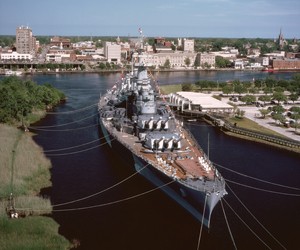For centuries, the North Carolina and South Carolina coasts have drawn visitors seeking beautiful beaches, gentle waves and relief from the inland heat.
However, visitors haven’t always sought a suntan and a round of beachside golf. Look back over the past few centuries and you find pirates on the lam from the Royal Navy, Confederate sailors breaking Union blockades, slaves and freedmen seeking a place to run their own lives, farmers trying to get their produce to market, and inventors taking flight in the first powered aircraft—or developing a fizzy cola with a rather pedestrian name: Brad’s Drink, later to become Pepsi-Cola.
Much of the coastal Carolinas’ history remains on display, and planners will find numerous ways to incorporate the thrilling days of yesteryear into agendas.
SOUTH CAROLINA
Myrtle Beach
Myrtle Beach is one of the most popular destinations on the coast, with hundreds of hotels, restaurants and attractions, and it anchors a dozen communities that are collectively known as the Grand Strand.
While Myrtle Beach has been a beach destination for the past century, Murrells Inlet was a hideout for the infamous pirate Blackbeard in the 18th century, while Little River hosted both pirates and Civil War-era blockade runners. The historically African American town of Atlantic Beach was for centuries a refuge for the descendants of slaves and the Geechee and Gullah communities, while relative newcomer North Myrtle Beach originated the Shag, a unique dance style still seen at area venues.
"Once you get into the South Strand, [it goes] back to plantation times in the 1700s and 1800s," says Kimberly Miles, public relations manager at the Myrtle Beach Area CVB. "At one point Georgetown, South Carolina, was the world’s largest rice exporter, and people who signed the Declaration [of Independence] are from this area."
Miles cites Hopsewee Plantation, the original home of Declaration signer Thomas Lynch Jr., as an ideal group-friendly experience. Lynch’s original plantation home is intact and groups can visit for lunch, tea service, dinner or a barbecue. Meanwhile, the L.W. Paul Living History Farm documents South Carolina farm life between 1900 and 1950. It is an actual working farm manned by volunteers who blacksmith, grind grits and make soap.
Charleston and the Resort Islands
Charleston is one of those places that combines a vivid sense of its own history with the amenities of a modern, midsize city.
A prosperous commercial town and beacon of religious tolerance in the Southeast, Charleston was almost completely destroyed during the Civil War and again by a 7.5 earthquake a few decades later. The city has persevered, however, and retains its distinctively late-19th century architecture, much of which is decked out in unique Caribbean colors.
Visitors can take walking tours of the city that focus on colonial, Civil War or religious history, says Linda Wohlfeil-Jones, tour director of Absolutely Charleston Destination Management, who also recommends visiting local plantation houses.
"We go with all our groups to Grayton Hall, the only one on the Ashley River that was not burned up. It belongs to the National Trust [for Historic Preservation]," she says.
Visitors can also take a ferry to Fort Sumter National Monument, tour the still-working Boone Hall Plantation, visit the aircraft carrier Yorktown museum or view cultural and natural-history artifacts at the Charleston Museum. Meanwhile, Middleton Place combines several aspects of the Coastal Carolinas, as it features a museum, landscaped gardens and period craftspeople on the 65-acre grounds of an 18th century rice plantation. All of these venues are also available for off-site events.
Charleston’s depth of history also makes antiquing a popular group activity, says Wohlfeil-Jones, who recently put together a special antique tour for the History Channel program American Pickers.
Groups can also incorporate the past into their stay by meeting at historic Charleston properties such as Planters Inn, Andrew Pinckney Inn, Mills House Hotel and Francis Marion Hotel.
Nearby resort locales such as Kiawah Island, Seabrook Island and Isle of Palms round off Charleston’s picture with beautiful waterside accommodations and plentiful golf.
Hilton Head Island
While Hilton Head Island is best known as a resort destination, Native American shell rings—piles of discarded shells indicating human habitation—indicate that the island has been inhabited for at least 10,000 years. Fast-forward to the first Spanish visitors arriving in the 1520s, followed by colonial-era sea-island cotton plantations, a Union occupation during the Civil War and Charles Fraser’s founding of the Sea Pines Resort in 1954, and you’ve got several centuries of history on hand, says Jack Reed, director of sales at the Hilton Head Island Visitor and Convention Bureau.
"Hilton Head is generally known as a golf, tennis and beach resort, but our history goes back to the Native Americans, the [European] explorers in the 1600s who left their mark, Revolutionary and Civil War battles, and the Gullah community who had been West African slaves," he says. "So you’ve got all these cultures blending on an island that’s known for golf and beaches."
Today, visitors can explore and hold events at Honey Horn Plantation, the island’s sole remaining plantation home, or head to the mainland town of Bluffton to tour Heyward House, the summer residence of a plantation owner.
Meanwhile, visitors to Sea Pines Resort can climb its Harbour Town Lighthouse, whose nine landings each display an aspect of Hilton Head history. The lighthouse also offers gorgeous views of Calibogue Sound and nearby Daufuskie Island.
NORTH CAROLINA
Outer Banks
The Outer Banks mark the northernmost point of the chain of barrier islands that protect the coastal Carolinas from hurricanes—while providing a made-to-order outdoor playground. But history abounds here as well, nowhere as prominently as at the Wright Brothers National Memorial in Kill Devil Hills. This is where Orville and Wilbur Wright succeeded in developing powered flight, and it attracts hordes of aviation buffs each year. Markers indicate where each of the brothers’ first flights took place, and visitors can see a replica of the Wrights’ flyer and hear well-informed park rangers give interpretive talks.
This area is also the gateway to Cape Hatteras National Seashore and Roanoke Island, site of the first attempt at a permanent English settlement—a bid that ended with the mysterious disappearance of all of the colonists. An outdoor symphonic drama, The Lost Colony, draws crowds each summer to the Fort Raleigh National Historic Site. Visitors can also take in the Elizabethan Gardens here or visit the northernmost branch of the North Carolina Aquarium. Starting in May 2011, the new Jennette’s Pier, another of the North Carolina Aquarium’s projects, will open in Nags Head with dedicated meeting space.
In Manteo, Roanoke Island Festival Park has both an American Indian Town and Outer Banks History Center that cover aspects of Outer Banks history from 1587 on, and the Elizabeth II, a replica of one of Raleigh’s vessels, lies at anchor. The park’s pavilion, gallery, small auditorium and theater are available to groups. Hatteras Island’s two giant lighthouses are an additional draw here, especially Cape Hatteras Lighthouse, which is open for climbing by the public. Other attractions here include the historic Chicamacomico Life Saving Station in the village of Rodanthe.
"It’s a hidden jewel; the folks there are very passionate about it," says Lorrie Love, tourism sales director at the Outer Banks Visitors Bureau.
The station still has one of its original surf-rescue boats, and visitors can watch a Breeches Buoy Rescue Reenactment—essentially a black-powder cannon that shot a buoy at ships in distress so that seamen could follow the line back to shore.
Other Outer Banks attractions include the Frisco Native American Museum in Frisco and the Graveyard of the Atlantic Museum in Hatteras Village.
Crystal Coast
Farther south along the Outer Banks is the Crystal Coast, which consists of both gorgeous barrier islands and communities such as Morehead City. Remarkably clear water offshore has combined with centuries of nearby shipwrecks to create a scuba-diving paradise, says Elizabeth Barrow, director of local public relations at the Crystal Coast Tourism Authority.
"We’re one of the top five overall diving destinations in the world, with 2,000 vessels off our coast, and our waters are warm so marine life just abounds. Once [divers] come here they’re pretty much sold," Barrow says.
Back on land, the Crystal Coast offers several venues that document the area’s maritime and cultural history, including the genealogy-focused History Place in Morehead City and the Pine Knoll Shores branch of the North Carolina Aquarium, both of which are available for rental. Visitors may also enjoy Fort Macon State Park and the Core Sound Waterfowl Museum & Heritage Center on Harkers Island, which keeps many of the Crystal Coast’s traditions alive through community programs that encourage decoy carving, quilting and boat restoration.
The area’s most popular attraction is Cape Lookout Lighthouse on Shackleford Island, according to Barrow.
"It’s one of seven natural barrier chain islands in the world [and has] horses left behind by Spanish settlers," she says.
New Bern and Craven County
New Bern is just inland from Cape Lookout National Seashore and north of Croatan National Forest. Located at the confluence of the Trent and Neuse Rivers, the city celebrated its 300th anniversary in 2010 with a year-long schedule of events, including a History Bowl, regatta, African American- and Native American-themed events, Civil War commemorations and a celebratory visit by a delegation from Bern, Switzerland, which is New Bern’s namesake and sister city.
The North Carolina History Center opened in October at Tryon Palace, New Bern’s major attraction. This Georgian-style structure was designed for Royal Governor William Tryon and completed in 1770, only to be destroyed by fire two decades later. It was rebuilt using the original design in the mid-20th century, and today visitors can tour its grounds guided by Palm Pilot-type devices. Elsewhere on the grounds, the new History Center is one of the state’s greenest buildings and gives visitors a look at both the natural and human history of this region, while the 200-seat Cullman Performance Hall is available for group use.
Many visitors enjoy a stop at the downtown store where Pepsi was invented or walking the trail commemorating the Civil War Battle of New Bern. Historic walking tours are highly popular, and groups can choose from themes of African-American heritage, the Revolutionary War, churches and cemeteries, historic homes and a new tour devoted to the books of author Nicholas Sparks, who set portions of The Notebook and Message in a Bottle here.
Wilmington and the Cape Fear Coast
Far from being the place of dread that it was for Gregory Peck and Nick Nolte in the two movie versions of Cape Fear, today’s Cape Fear Coast combines the history of urban Wilmington with a string of beautiful beaches and beach towns. Wilmington proper has a 230-block historic district that includes a highly walkable shop- and restaurant-filled commercial district along the Cape Fear River, says Connie Nelson, public relations and communications director for the Wilmington/Cape Fear Coast CVB.
"We also have the battleship North Carolina, which is a World War II memorial, and if you’re downtown it’s just across the river from the historic district," Nelson says. "It’s also a unique meeting venue, and one popular thing to do is have a luau on the [battleship’s] fantail because the North Carolina served in the Pacific during World War II."
The Cape Fear Coast offers three island beaches on two barrier islands—Wrightsville Beach, which is a short drive over a bridge from Wilmington, and Carolina and Curie beaches, which are located on Pleasure Island about a half-hour ride from downtown.
"That’s definitely a plus, knowing they have the option of river and sea," Nelson says, adding that the area’s three most popular attractions are the Fort Fisher State Historic Site and Civil War Museum and the North Carolina Aquarium, both on Pleasure Island, and the Bellamy Mansion in downtown Wilmington, which was commandeered by Union forces as a headquarters during the Civil War.
Other attractions groups can take advantage of include horse-drawn carriage tours, trolley tours, ghost walks and even a haunted pub crawl. Wilmington is also a surprisingly busy location for U.S. television and movie production, and Screen Gems Studios has a production facility here that offers studio tours. There’s also a Hollywood Location Walk that takes visitors around various filming sites.
Paul D. Kretkowski writes frequently about travel, food and sports. He is also the founder of Beacon (www.softpowerbeacon.blogspot.com), a blog about foreign policy.






